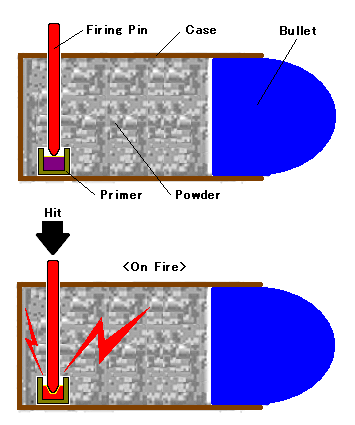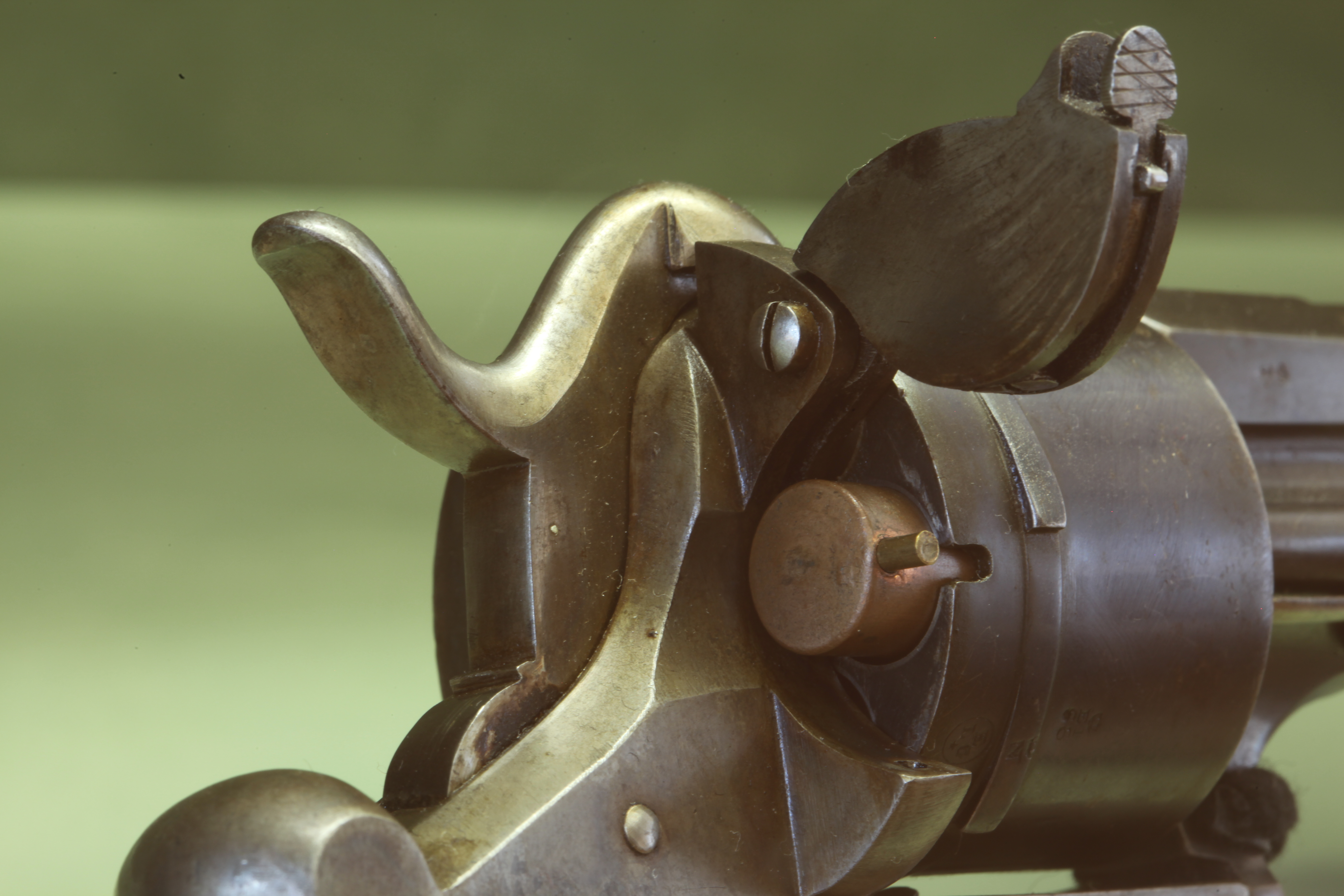Pinfire cartridge on:
[Wikipedia]
[Google]
[Amazon]

 A pinfire cartridge is an obsolete type of metallic
A pinfire cartridge is an obsolete type of metallic
 The Swiss gun maker Samuel Joannes Pauly patented the first breechloading cartridge in 1812. This was for use in a shotgun with fixed barrels which was loaded by lifting a breech block on the top. French gun maker Henri Roux attempted to improve this cartridge in the 1820s but a constantly primed cartridge was felt by many to be too dangerous and many breechloading guns reverted to using an unprimed cartridge. This was fired by a separate percussion cap which was used on the still dominant muzzle-loading guns.
The Swiss gun maker Samuel Joannes Pauly patented the first breechloading cartridge in 1812. This was for use in a shotgun with fixed barrels which was loaded by lifting a breech block on the top. French gun maker Henri Roux attempted to improve this cartridge in the 1820s but a constantly primed cartridge was felt by many to be too dangerous and many breechloading guns reverted to using an unprimed cartridge. This was fired by a separate percussion cap which was used on the still dominant muzzle-loading guns.
File:Ethan Allen Pinfire Cartridge Box.jpg, Pinfire Cartridge Box by Ethan Allen & Co.
File:Pinfire Cartridge Box by Allen & Wheelock & Co..jpg, Pinfire Cartridge Box by Allen & Wheelock & Co.
File:Pinfire Cartridge Box by C.D. Leet & Co. .jpg, Pinfire Cartridge Box by C.D. Leet & Co.
File:Pinfire Cartridge Boxes by Union Metallic Cartridge Company.jpg, Pinfire Cartridge Boxes by Union Metallic Cartridge Company
File:Eley Brothers Pinfire Cartridge Box.jpg, Pinfire Cartridge Box by Eley Brothers
File:Kynoch & Co. Pinfire Cartridge Box.jpg, Pinfire Cartridge Box by Kynoch & Co.

firearm cartridge
A cartridge or a round is a type of pre-assembled firearm ammunition packaging a projectile (bullet, shot (pellet), shot, or shotgun slug, slug), a propellant substance (usually either smokeless powder or black powder) and an ignition device ( ...
in which the priming compound is ignited by striking a small pin which protrudes radially from just above the base of the cartridge. Invented by Frenchman Casimir Lefaucheux
Casimir Lefaucheux (; 26 January 1802 – 9 August 1852) was a French gunsmith. He was born in Bonnétable and died in Paris.
Casimir Lefaucheux obtained his first patent in 1827. In 1832, he completed a drop-barrel sporting gun with paper-cased ...
in the 1830s but not patented until 1835, it was one of the earliest practical designs of a metallic cartridge. Its history is closely associated with the development of the breechloader which replaced muzzle-loading weapons.
History
Casimir Lefaucheux
Casimir Lefaucheux (; 26 January 1802 – 9 August 1852) was a French gunsmith. He was born in Bonnétable and died in Paris.
Casimir Lefaucheux obtained his first patent in 1827. In 1832, he completed a drop-barrel sporting gun with paper-cased ...
of Paris decided in 1832 to patent a breechloader where the barrel hinged downwards to reveal the breech ends. These still used a separate percussion cap. Though used before this, (as seen in surviving pinfire shotshells that lists the names of early gun makers he signed contracts with in 1833 and 1834,)
in 1835FR patent 6348, Casimir Lefaucheux, "fusil se chargeant par la culasse, au moyen d'un mécanisme qui fait basculer le canon", filed 1835-01-08, issued 1835-03-31 he was granted an addition to the 1832 patent for a new type of cartridge in which the cartridge's priming
Priming may refer to:
* Priming (agriculture), a form of seed planting preparation, in which seeds are soaked before planting
* Priming (immunology), a process occurring when a specific antigen is presented to naive lymphocytes causing them to d ...
compound is ignited by striking a small pin which protrudes radially from just above the base of the cartridge. These pins fitted into a small groove cut in the top of each barrel-end and made it easy to see if the gun was loaded. The interior side of the chamber served as an anvil so that the cap won't move, which was a problem in some early cartridge designs at the time. The cartridge used metal bases (often brass) with paper tubes which were usually loaded by the shooter or his staff but were not entirely gas-tight. This reduced the force of the charge and allowed powder residue and gas to escape.
The pinfire cartridge was greatly improved by the 1846 patent (number 1963) by Benjamin Houllier of Paris which introduced a base wad and effectively made the cartridge gas-tight which greatly improved the performance. They were cheap and clean shooting. These improved pinfire guns grew in popularity in France and some were imported by British gun makers to overwhelming indifference on the part of the gun users there. They were prejudiced technically against a gun that 'broke' in the middle, despite the much vaunted benefits of breechloading. They owned muzzle-loaders of exquisite perfection, considered themselves the best engineers in the world (inventing the Industrial Revolution), and had a poor view of the French - the old enemy and an unreliable ally.
It was not until the Great Exhibition of 1851 was held in London that breechloading guns were taken more seriously by British and American gun makers in particular. The display of a Lefaucheux breechloading gun inspired English apprentice gunmaker Edwin Charles Hodges (1831–1925) to make an improved copy and persuade leading London gun maker Joseph Lang that this was the gun of the future. Lang was universally credited to be the first established British gunmaker to produce pinfires in any numbers. His first weapon of this new type was produced in 1853. Other British gun makers including Lancaster, Blanch and Reilly were similarly inspired by French originals and improved pinfire breechloaders became the new type of gun which by 1857–8 every fashionable British prince and titled gentleman wanted to have. EC Hodges continued to make a good living as a specialist independent maker of breechloading actions commissioned by leading gunmakers such as Boss, Lancaster, Egg, Grant, Atkin, Rigby, Dickson, Purdey, Woodward, Army and Navy, and many others.
After Casimir's death in 1852, his son Eugene continued to market the pinfire design with great success. It became increasingly popular in Europe and large numbers of shotguns and revolvers (often called Lefaucheux guns after their inventor whoever the maker was), were manufactured from the mid-1850s until the 1890s. They were quicker and easier to load than percussion weapons with loose black powder, percussion caps and bullet; and they were also much more likely to fire reliably when wet. Pinfire cartridges were available in a large number of sizes for various types of weapon.
While pinfire shotguns declined from the early 1860s after the introduction of mass-produced centerfire shotgun cartridges, pinfire revolvers in particular became very successful and widespread, being adopted by the armies of France
France (), officially the French Republic ( ), is a country primarily located in Western Europe. It also comprises of overseas regions and territories in the Americas and the Atlantic, Pacific and Indian Oceans. Its metropolitan area ...
, Italy
Italy ( it, Italia ), officially the Italian Republic, ) or the Republic of Italy, is a country in Southern Europe. It is located in the middle of the Mediterranean Sea, and its territory largely coincides with the homonymous geographical ...
, Spain
, image_flag = Bandera de España.svg
, image_coat = Escudo de España (mazonado).svg
, national_motto = ''Plus ultra'' (Latin)(English: "Further Beyond")
, national_anthem = (English: "Royal March")
, i ...
, Switzerland, Sweden and others. They were also widely used during the American Civil War
The American Civil War (April 12, 1861 – May 26, 1865; also known by other names) was a civil war in the United States. It was fought between the Union ("the North") and the Confederacy ("the South"), the latter formed by states ...
, although sometimes despised because of their low power compared to Colt and other percussion revolvers. Some navies also adopted them, "sea service" examples often being made out of brass
Brass is an alloy of copper (Cu) and zinc (Zn), in proportions which can be varied to achieve different mechanical, electrical, and chemical properties. It is a substitutional alloy: atoms of the two constituents may replace each other wit ...
which is largely unaffected by the corrosion
Corrosion is a natural process that converts a refined metal into a more chemically stable oxide. It is the gradual deterioration of materials (usually a metal) by chemical or electrochemical reaction with their environment. Corrosion engi ...
caused by salt
Salt is a mineral composed primarily of sodium chloride (NaCl), a chemical compound belonging to the larger class of salts; salt in the form of a natural crystalline mineral is known as rock salt or halite. Salt is present in vast quant ...
.
Pinfire became obsolete once reliable rimfire and centerfire
Two rounds of .357 Magnum, a centerfire cartridge; notice the circular primer in the center
A centerfire cartridge is a firearm metallic cartridge whose primer is located at the center of the base of its casing (i.e. "case head"). Unlike rim ...
cartridges became available because without a pin which needed aligning in the slot in the chamber wall they were quicker to load. They were also safer because they had no protruding pin which could cause the ammunition to accidentally detonate during rough handling, particularly of loose ammunition.
American manufacturers
* Ethan Allen & Co. of Worcester, Massachusetts * Allen & Wheelock of Worcester, Massachusetts * C.D. Leet & Co. of Springfield, Massachusetts * C. Sharps & Co. of Philadelphia, Pennsylvania *Union Metallic Cartridge Company
The Union Metallic Cartridge Company (UMC) was an early manufacturer of cartridge ammunition for small arms. The company was founded in 1867 during the most rapid evolution of cartridge design to date. Following merger with Remington Arms in 1912, ...
of Bridgeport, Connecticut
*William Tibbals of South Coventry, Connecticut
British manufacturers
*Eley Brothers
Eley Limited is a British manufacturer of firearms cartridges. Historically the company has produced a broad variety of ammunition, but today specialises in .22 Long Rifle cartridges for competitive target shooting. At the 2020 Tokyo Olympics, si ...
of London
* Kynoch & Co. of Birmingham
Current status
Although pinfire cartridges and shotgun shells are technically obsolete, as pinfire guns have not been made in any numbers for a hundred years, enthusiasts of vintage weaponry often make pinfire cartridges from modern materials and shoot their old guns. As regards pistols, some modern novelty miniature guns are manufactured in very tiny calibers, such as 2mm. Although not practical weapons, they use pinfire ammunition because the caliber is too small for centerfire or rimfire. Antique pinfire firearms and cartridges are available on the collector market and modern reloading kits exist which contain specialized cartridges which can be hand loaded, though the process is far more complex than for centerfire cartridges."To Shoot My Pinfire" by Darrel G Dennis inSee also
*List of handgun cartridges
List of handgun cartridges, approximately in order of increasing caliber.
Table of handgun cartridges
{, class="wikitable sortable" style="text-align:left"
, -
! Cartridge name , , Bulletdiameter , , Caselength , , Cartridgelength , , Type , ...
Notes
{{reflist Ammunition